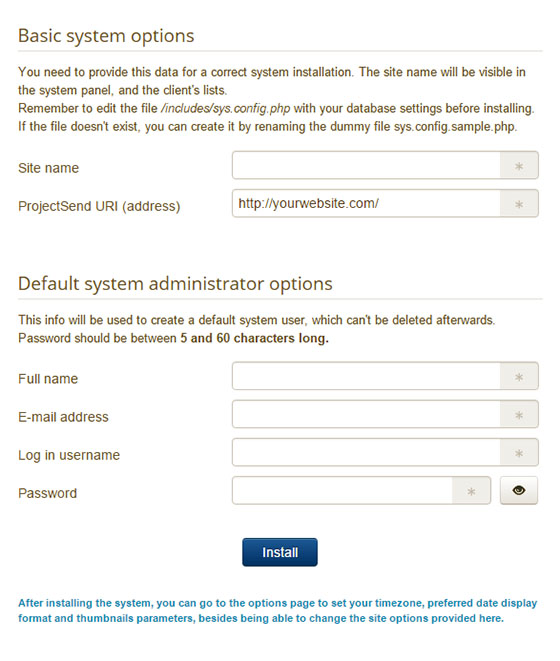
In this tutorial, we will show you how to install and configuration of ProjectSend on your CentOS 7. For those of you who didn’t know, ProjectSend is an open-source file and image sharing application that lets you upload files & assign those files to specific users which you create yourself from the Web Interface of ProjectSend as well as to the general public. ProjectSend is written in PHP and uses a MySQL database to store the information.
This article assumes you have at least basic knowledge of Linux, know how to use the shell, and most importantly, you host your site on your own VPS. The installation is quite simple and assumes you are running in the root account, if not you may need to add ‘sudo‘ to the commands to get root privileges. I will show you the step-by-step installation ProjectSend on a CentOS 7 server.
Prerequisites
- A server running one of the following operating systems: CentOS 7.
- It’s recommended that you use a fresh OS install to prevent any potential issues.
- SSH access to the server (or just open Terminal if you’re on a desktop).
- A
non-root sudo useror access to theroot user. We recommend acting as anon-root sudo user, however, as you can harm your system if you’re not careful when acting as the root.
Install ProjectSend on CentOS 7
Step 1. First, let’s start by ensuring your system is up-to-date.
yum -y update
Step 2. Install LAMP server.
A CentOS 7 LAMP server is required. If you do not have LAMP installed, you can follow our guide here. Also, install the required PHP modules:
yum install php-mysql php-gd php-ldap php-odbc php-pear php-xml php-xmlrpc php-mbstring php-snmp php-mcrypt
Step 3. Installing ProjectSend.
The first thing to do is to go to ProjectSend’s download page and download the latest stable version of ProjectSend:
wget https://github.com/ignacionelson/ProjectSend/archive/master.zip
Unpack the ProjectSend archive to the document root directory on your server:
unzip master.zip mv ProjectSend-master /var/www/html/projectsend
We will need to change some folders permissions:
chown apache: -R /var/www/html/projectsend
Step 4. Configuring MariaDB for ProjectSend.
By default, MariaDB is not hardened. You can secure MariaDB using the mysql_secure_installation script. you should read and below each step carefully which will set a root password, remove anonymous users, disallow remote root login, and remove the test database and access to secure MariaDB:
mysql_secure_installation
Configure it like this:
- Set root password? [Y/n] y - Remove anonymous users? [Y/n] y - Disallow root login remotely? [Y/n] y - Remove test database and access to it? [Y/n] y - Reload privilege tables now? [Y/n] y
Next, we will need to log in to the MariaDB console and create a database for the ProjectSend. Run the following command:
mysql -u root -p
This will prompt you for a password, so enter your MariaDB root password and hit Enter. Once you are logged in to your database server you need to create a database for ProjectSend installation:
CREATE DATABASE projectsenddb; GRANT ALL PRIVILEGES ON projectsenddb.* TO 'projectsenduser'@'localhost' IDENTIFIED BY 'your-password' WITH GRANT OPTION; FLUSH PRIVILEGES; quit
Next, Rename the ‘sys.config.sample.php’ file to ‘sys.config.php’:
cd /var/www/html/projectsend/includes mv sys.config.sample.php sys.config.php
Open the ProjectSend configuration file with your favorite text editor:
### nano sys.config.php
/** MySQL database name */
define('DB_NAME', 'projectsenddb');
/** Database host (in most cases it's localhost) */
define('DB_HOST', 'localhost');
/** MySQL username (must be assigned to the database) */
define('DB_USER', 'projectsenduser');
/** MySQL password */
define('DB_PASSWORD', 'your-password');
Step 5. Configuring Apache web server for ProjectSend.
We will create an Apache virtual host for your WordPress website. First, create ‘/etc/httpd/conf.d/vhosts.conf’ file with using a text editor of your choice:
nano /etc/httpd/conf.d/vhosts.conf IncludeOptional vhosts.d/*.conf
Next, create the virtual host:
mkdir /etc/httpd/vhosts.d/ nano /etc/httpd/vhosts.d/yourdomain.com.conf
Add the following lines:
<VirtualHost YOUR_SERVER_IP:80> ServerAdmin webmaster@yourdomain.com DocumentRoot "/var/www/html/projectsend/" ServerName yourdomain.com ServerAlias www.yourdomain.com ErrorLog "/var/log/httpd/yourdomain.com-error_log" CustomLog "/var/log/httpd/yourdomain.com-access_log" combined <Directory "/var/www/html/projectsend/"> DirectoryIndex index.html index.php Options FollowSymLinks AllowOverride All Require all granted </Directory> </VirtualHost>
Save and close the file. Restart the apache service for the changes to take effect:
systemctl restart httpd.service
Step 6. Accessing ProjectSend.
ProjectSend will be available on HTTP port 80 by default. Open your favorite browser and navigate to http://your-domain.com or http://server-ip and complete the required steps to finish the installation. If you are using a firewall, please open port 80 to enable access to the control panel.

Congratulations! You have successfully installed ProjectSend. Thanks for using this tutorial for installing ProjectSend on CentOS 7 system. For additional help or useful information, we recommend you to check the official ProjectSend website.